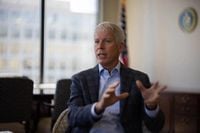Electricity prices in the United States are climbing at more than twice the rate of inflation, putting pressure on households and fueling a fierce political debate over the causes and solutions to the country’s energy woes. President Donald Trump, who campaigned on a promise to slash Americans’ energy costs by half, now finds himself at the center of criticism as prices continue to soar and his administration’s policies come under scrutiny from both sides of the political aisle.
In a series of social media posts, President Trump has placed the blame squarely on renewable energy sources, calling wind and solar power “THE SCAM OF THE CENTURY!” and vowing to block new wind and "farmer destroying Solar" projects. “The days of stupidity are over in the USA!!!” he declared on Truth Social, signaling a sharp turn away from clean energy initiatives that had gained momentum under previous administrations.
Yet, according to energy analysts and industry experts, the real reasons behind the surge in electricity prices are far more complex—and renewables are not the main culprit. As reported by the Associated Press, factors such as increased overall demand, aging infrastructure, and extreme weather events exacerbated by climate change are driving prices higher. The rapid expansion of cloud computing and artificial intelligence has fueled a boom in energy-hungry data centers, which require vast amounts of power to run servers, storage systems, and cooling equipment. The growing adoption of electric vehicles has also added to the grid’s load, even as the Trump administration and congressional Republicans have moved to restrict tax credits and other incentives for EVs previously approved under President Biden.
Natural gas, which generates more than 40% of U.S. electricity, has seen prices spike sharply due to rising exports to Europe and other international buyers. This has further contributed to the mounting bills faced by American families. Trump’s campaign promise to cut electric bills by half within 18 months has not materialized—instead, prices have risen steadily since he took office eight months ago, with the past year seeing increases nearly double the inflation rate, according to data cited by Heatmap and other outlets.
Democrats have been quick to turn the blame back on Trump. Citing the recent tax-and-spending cut bill passed by Republicans, which restricts clean energy incentives, they argue that the administration’s actions are directly responsible for higher energy costs. “Now more than ever, we need more energy, not less, to meet our increased energy demand and power our grid. Instead of increasing our energy supply Donald Trump is taking a sledgehammer to the clean energy sector, killing jobs and projects,” said New Mexico Senator Martin Heinrich, the top Democrat on the Senate Energy and Natural Resources Committee.
Heinrich and other critics point to a report from Energy Innovation, a non-partisan think tank, which found that the GOP tax law will increase the average family’s energy bill by $130 annually by 2030. The report warns that by quickly phasing out technology-neutral clean energy tax credits and imposing new sourcing requirements, the law will “significantly hamper the development of domestic electricity generation capacity.”
Renewable energy advocates have responded with even sharper language. “The real scam is blaming solar for fossil fuel price spikes,” the Solar Energy Industries Association said in response to Trump’s accusations. The group added, “Farmers, families, and businesses choose solar to save money, preserve land, and escape high costs of the old, dirty fuels being forced on them by this administration.”
Data from the U.S. Energy Information Administration supports their claims: more than 90% of new energy capacity that came online in the U.S. in 2024 was clean energy. States with the highest share of clean energy production have actually seen prices decline in the past year, while those with the least renewable energy use experienced price hikes. “By slowing clean energy deployment, the Trump administration is directly fueling cost increases,” Jason Grumet, CEO of the American Clean Power Association, told the AP. Ted Kelly, director of U.S. clean energy for the Environmental Defense Fund, added, “Blocking cheap, clean energy while doubling down on outdated fossil fuels makes no economic or environmental sense.”
But the debate isn’t strictly partisan. Iowa Senator Chuck Grassley, a Republican and longtime supporter of wind power, has placed a hold on three Treasury nominees to ensure an “appropriate glidepath for the orderly phase-out of the tax credits” approved in the 2022 climate law. Grassley was encouraged by new Treasury guidance that limits, but does not eliminate, those credits, saying it “seems to offer a viable path forward for the wind and solar industries to continue to meet increased energy demand.”
Meanwhile, the cost of upgrading the nation’s aging electrical grid is emerging as a major driver of price hikes—a point highlighted by Heatmap’s Robinson Meyer. In 2023 alone, utilities spent roughly $6 billion more on grid infrastructure than they did in 2019, and investor-owned electric companies are expected to invest close to $38 billion in grid transmission this year, an $8 billion jump from two years ago. The Trump administration’s expanded tariffs on steel and aluminum imports, which now include critical grid components like transformers, are making these upgrades even more expensive. Lead times for transformers have ballooned from three to six months in 2019 to as much as 30 months in 2023, and higher costs are being passed on to consumers.
The explosive growth of AI data centers is further straining the grid and driving up costs. As reported by various outlets, utilities have requested $29 billion in rate hikes in 2025 as a direct response to AI demand. Data center energy demand could nearly double by 2030, reaching up to 9% of total U.S. power use. In regions like the PJM grid, which covers parts of the Midwest and Mid-Atlantic, data centers have helped drive capacity auction prices up by more than 800% this summer, increasing wholesale electricity rates by 22%. Residents could face rate increases of up to 60% over the next five years.
Low-income households, renters, rural communities, and communities of color are among those hit hardest by these rising costs, a point underscored by reporting on environmental and health concerns linked to AI data center operations. In Memphis, for example, an xAI data center has faced backlash for polluting the air with methane turbines emitting greenhouse gases and carcinogenic formaldehyde above federal limits in a majority-Black neighborhood. In Texas, Microsoft’s AI water usage is believed to be contributing to droughts, forcing residents to ration water.
The Inflation Reduction Act of 2022 was designed to tackle these challenges by expanding clean, affordable energy and lowering household energy costs. However, in July 2025, Republicans repealed or significantly rolled back many of those incentives, just as AI demand was surging. The new federal agenda now promotes the rapid growth of data centers with little environmental or economic accountability.
John Quigley, a senior fellow at the Kleinman Center for Energy Policy, warned that the Republican tax law could eliminate as many as 45,000 jobs by 2030 and described the Trump administration’s emphasis on fossil fuels as “an extremely backward force in this conversation.” He added, “Besides ceding the clean energy future to other nations, we are paying for fossil foolishness with more than money — with our health and with our safety. And our children will pay an even higher price.”
As the debate rages on, Americans are left to grapple with mounting bills, a fragile grid, and a political landscape where blame is as abundant as the summer heat. The nation’s energy future—and who will pay for it—remains uncertain, but one thing is clear: the stakes have never been higher.






